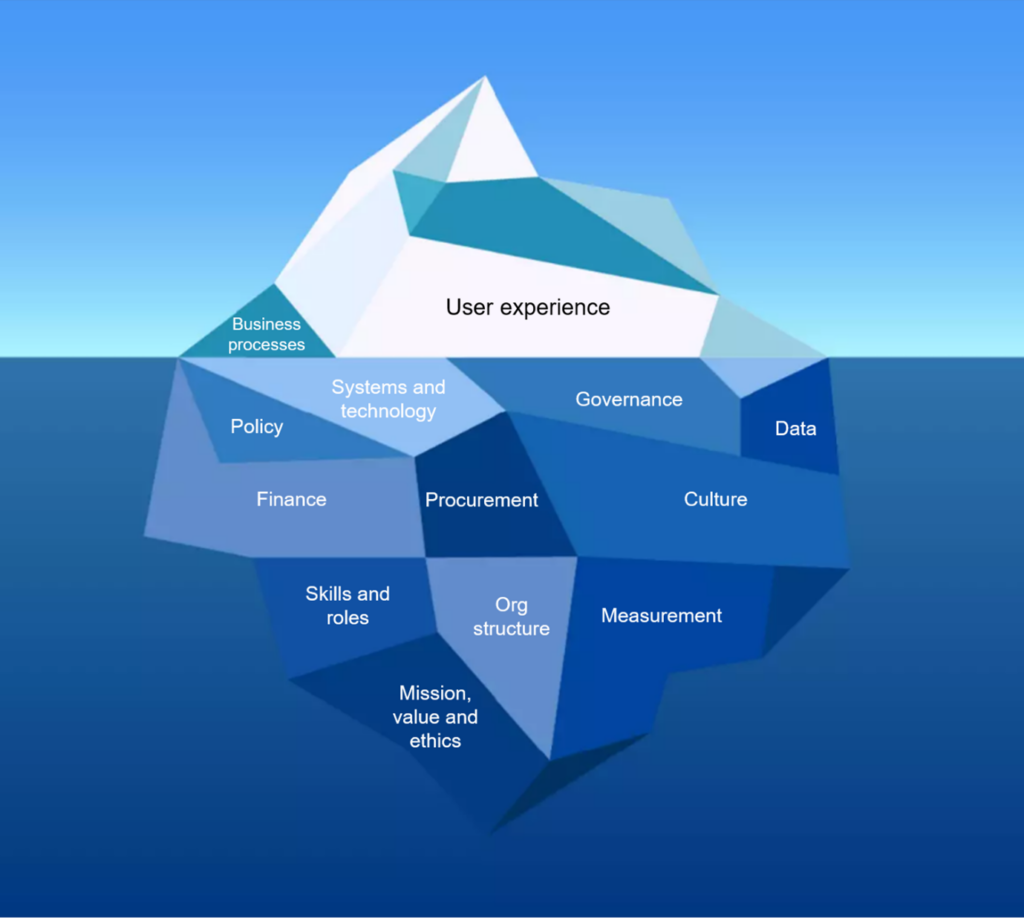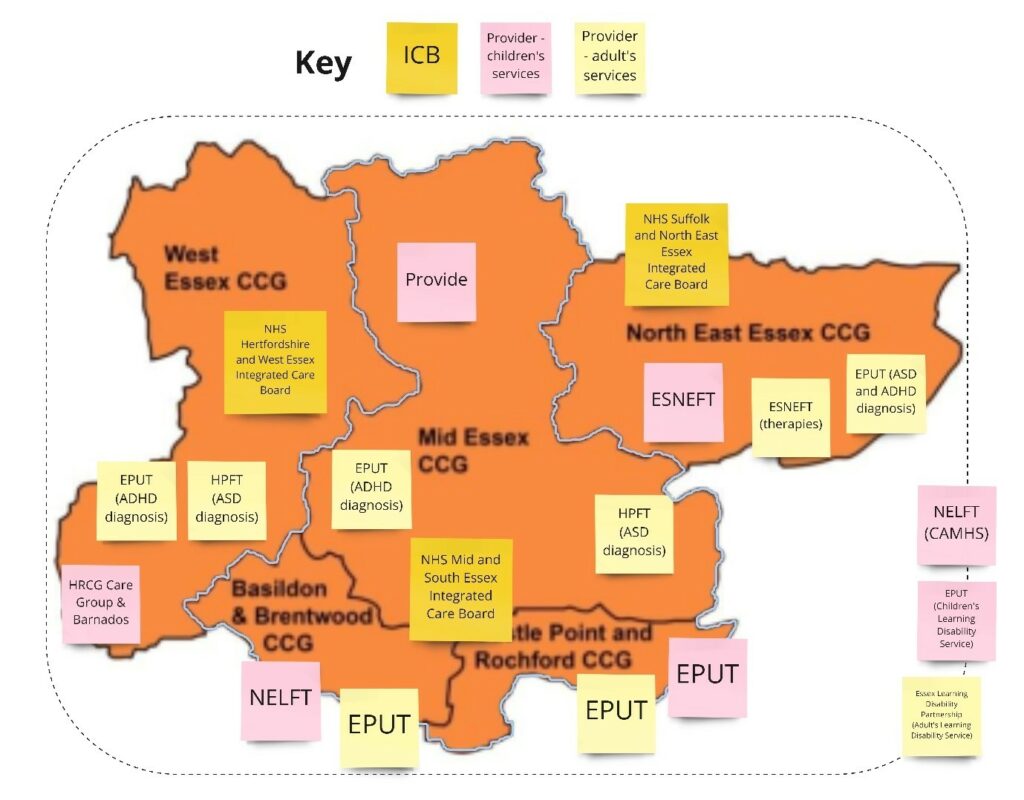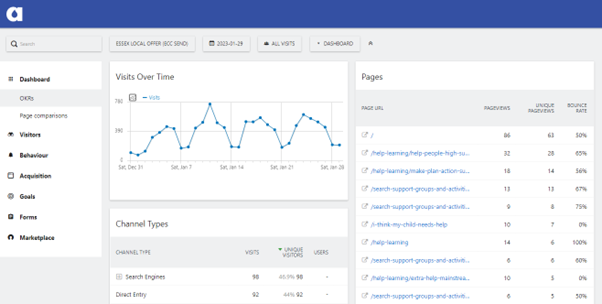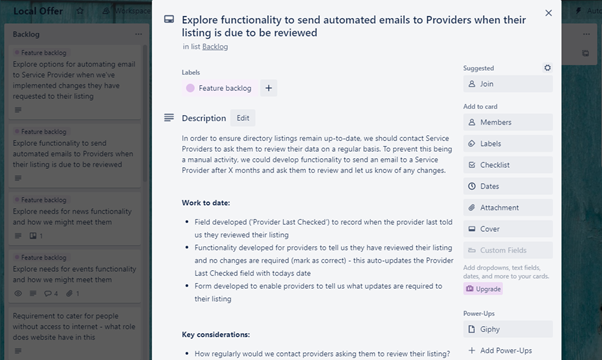In December 2022 we launched the new SEND Local Offer online service. Over the past 18 months we have worked with SEND colleagues and a wider interest group of over 100 people to design and develop the new site.
Throughout the development we’ve focused on the needs of families and professionals. We've worked in open and collaborative ways to build understanding and create the best possible user experience.
The ownership of the service will now transition over to SEND colleagues. It will be their responsibility to manage and improve things on an ongoing basis.
This post focuses on the work we have been doing in the background with our partners and the SEND team. We need to make sure the team have the right support, skills, and capacity to maintain and improve the service.
The user experience is not designed in isolation
A successful service is about much more than the user experience, which isn’t ever designed in isolation. We often refer to Sarah’s Drummond’s full stack service design model. It highlights the elements that sit ‘under the waterline’ and need to be aligned to support an effective service.

We’ve encouraged SEND colleagues to take an active role throughout the site development, as we've found this is the best way for them to understand what it means to be the owner of an effective, sustainable digital service.
Colleagues have been enthusiastic and have actively embraced our ways of working, but the ownership and management of an online service is often ‘bolted on’ to people’s existing roles. They have to balance the work to maintain and develop the site against their other day-to-day responsibilities.
So, to set the team and service up for success here’s some of the areas we’ve focused on in our handover of the service.
1) Building relationships with health partners to improve our directory of services
An important focus for the new Local Offer has been to provide better information about health services available for children and young people with SEND in Essex.
We wanted to make it easier for families to find out about the health services available in their area, but no one really had a clear view of all the services available across the county.
The health landscape in Essex is particularly complex. Rather than just having one NHS organisation responsible for the provision of health services, known as an Integrated Care Board (ICB), we have three. These ICBs commission providers to deliver the healthcare services within their area, and often commission different providers for children and adults' services.
So, we’ve been working to pull together a view of the services. We’ve been asking lots of questions and forging relationships with our health partners to give us a much better understanding of the services available in Essex. This means we can add those services to the Local Offer directory, to make them easier for families to find.

But building the directory is just the start. It’s important that the services within the directory and the information about them stays up to date. To set that up for success we’ve started making introductions between the SEND team and the health partners we’ve identified. These new relationships will help to keep things current. We’ve also documented everything we’ve found out about the health landscape in Essex, so the team have a resource they can refer to and continue to build over time.
2) Developing a performance measurement framework to understand if the Local Offer is meeting user’s needs
Now the Local Offer has launched, the SEND team will need to know how well the service is working for users.
We’ve worked with our SEND colleagues to develop a performance measurement framework for the new site. It sets out the objectives we want the new Local Offer meet, the metrics we will collect as indicators and the tools we’ll use to measure how the service is performing against them.
Some of the data needed for the metrics can be collected using Matomo, the web analytics platform we’ve implemented to track and analyse traffic to the Local Offer. This is the first time we’ve used Matomo at Essex County Council, so we’ve been getting to grips with the platform and its available functionality. It’s also our first cookieless web analytics implementation, and we’ve been learning some lessons about the trade-offs between valuing users' privacy and performance measurement when going cookieless. We’ve developed dashboards within Matomo to bring together the most important reports into a single view.

There are other important metrics that can be monitored using data we collect within LocalGov Drupal, the open source and community developed platform we’ve built the Local Offer on. We’ve developed functionality and reports that will enable us to monitor how regularly directory listings are being validated by Service Providers, and how many new Service Providers request to add their service to the directory.
The dashboards and reports we’ve established will enable the SEND team to quickly and easily monitor some of the key metrics set out in the Performance Measurement Framework. The insights gained from this will be combined with those from ongoing user research to help establish how well the Local Offer is meeting the agreed objectives.
3) Helping our SEND colleagues to feel confident in maintaining the Local Offer
We’ve been delivering training to our SEND colleagues to help them develop the knowledge and skills to maintain the site. The training has covered writing web content that’s accessible and follows our content guidelines, as well as how to use the LocalGov Drupal functionality.
We started training a few months before the handover. This meant we could deliver it in bitesize chunks, rather than overwhelming the team with lots of information. It’s also meant that they could start building their confidence in maintaining the Local Offer before they took over the reins from us.
We made the training as interactive as possible, enabling the team to learn by doing. We planned some exercises that our SEND colleagues could work through to put to practise the topics we covered during the sessions. We also included reflection breaks during the sessions, giving the team time to think about any challenges they might face or any areas they were concerned about. We then chatted these reflections through as a group which helped to ease concerns and identify areas that required further training.

As were delivering the training, we were also developing guidance documents so the SEND team would have materials to refer to when they are maintaining the Local Offer. Doing it in this way meant we could test out the guidance documents as part of the training session and get feedback quickly. It helped us identify gaps in the materials which we could address, and ensured the team were familiar with the documents ahead of the handover.
4) Supporting the transition from a development project to a live, departmentally owned and managed service
We’ve been working with SEND team to plan how they will sustainably run the service. There is no longer a need to have a dedicated agile team working on the Local Offer 100% of the time, but they will want to ensure it is managed effectively and continue to iterate and make improvements to it.
Throughout the development we’ve used a Trello board to manage our work. Within the board we kept a list of the new features, bug fixes and other activities that could be delivered as we built the Local Offer, this is called our product backlog. Our backlog has been continually prioritised throughout the development, and not everything on the list has been done. As we handover the running of the service, our backlog will become the SEND team’s backlog, so we’ve been giving it a good tidy up. We’ve made sure the descriptions are clear, added details of any work we had started and documented any key considerations so the SEND team can use it to make informed decisions about what to do next.

We’ve been establishing how the live service will be managed and supported, making sure the basics like bug fixes and security updates are covered. Our development partner, Annertech, will manage the live service. We’ve been working with them to get the managed service up and running and ensure everyone is comfortable with the new ways of working.
We’ve also worked with the SEND team to ensure the Local Offer is backed by a plan and budget that allows for continuous improvement throughout its lifetime. They will continue to partner with Invuse, who will carry out ongoing user research and combine the insights gained from that with the metrics monitored as part of our Performance Measurement Framework to iterate and improve the service based on insights.
We’ve established monthly meetings where we, alongside our colleagues from Invuse and Annertech, will join the SEND team to review site performance and the backlog and decide on areas of focus for the coming month and beyond.
Learning lessons for our team development
As well as designing the handover, we have also been reflecting on the lessons learned for our team. This includes:
- How we work with suppliers: how can we improve the time it takes to contract, onboard, and establish ways of working in a blended team?
- How we engage with peers/communities: how do we contribute and learn from the work of other organisations, especially around common platforms like LocalGov Drupal?
- How we reuse the design work on the Local Offer to speed up future projects: we’re thinking about an MVP design system and how this can help us to speed up future work
- #MEGARETRO!: we spent a whole day over the Christmas break reflecting on what went well, what we would have done differently, what we learned and what we want to share. This was a fun and energising way to reflect, discuss and capture our lessons learned, and to mark the transition of the new site. We’ll be following up with a further post on this soon.
The essential, invisible work that supports service success
We’ve learned so much over the development of the new Local Offer service. This is the first time we have developed a new service which will be handed over to a functional team, so we’ve had to work hard to package up our learning in ways that will set up colleagues for success. We now have an exemplar for this type of product development, so next time will be easier!
Does this resonate with work that you have done in the background to ensure service success? Are there things we’ve missed or could have done better? Let us know your tips for effective handover in the comments below.
Leave a comment